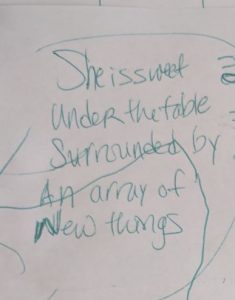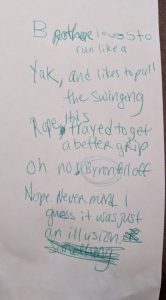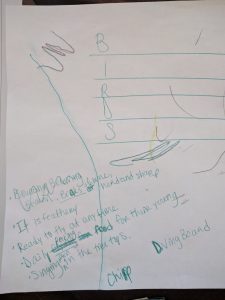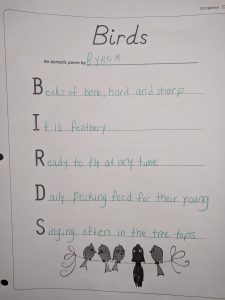
How to Write Acrostic Poems with Your Kids
An acrostic poem is the kind of poem that looks like this:
Piecing words together
On paper like this
Emits a certain
Memory
Well, that’s just the first thing that came to mind. Do you get what it is now, though? Acrostic is not often used as high literature, but it is a fun way to help kids write poetry.
We use The Good and the Beautiful language arts, level 2. It’s good. It’s beautiful. It’s free. It’s absolutely sufficient for us right now.
Our last lesson was about poetry. My son read two poems out loud and then was supposed to write two acrostic poems. My son is eight years old and he does not like to write. Sometimes this is because he doesn’t like to physically write, and sometimes it’s because he doesn’t want to come up with ideas. On this day, I believe both were at play.
I am a writer. This is the stuff I live for. It’s always a little bit heartbreaking when my son doesn’t like it.
Poetry is not a need, but it does help with so much understanding. It delves deep into humanity. It requires extra thinking. It brings pleasant surprises. It can be a great joy to homeschool life. My kids are little (my oldest is 8 years old), so we mostly read sweet and silly poetry books like A Child’s Garden of Verses and Sing a Song of Popcorn. These children’s poems rely heavily on images and are light in nature. We also read the poetry of A.A. Milne quite a bit. Every once in a while, I pull out my big literature book and we’ll read poems like “After Apple Picking” or “I Wondered Lonely as a Cloud” or whatever flits to me as we go through the seasons of life.
Andrew Simmons wrote in The Atlantic “Yet poetry enables teachers to teach their students how to write, read, and understand any text. Poetry can give students a healthy outlet for surging emotions. Reading original poetry aloud in class can foster trust and empathy in the classroom community, while also emphasizing speaking and listening skills that are often neglected in high school literature classes.” He is speaking of a kind of poetry my kids have not yet seen, but I believe this still applies to a child’s early years.
That is to say, simply, that I understand this lesson on acrostics was not critical to my son’s development. But if I could help him through it, and if we could find some joy together within the lesson, then we would.
First, my son was supposed to write an acrostic of his own name. We read an example in the lesson, but he was still unsure. He thought he couldn’t do one himself. He didn’t know where to start.
I wrote one with his sister’s name, to show him how it’s done (yes, this is on a random piece of scrap paper):

He thought this was silly. I showed him how, even though the word was “Susan” I didn’t write her name into the poem. Instead, I wrote about her, describing her actions. This is not a requirement of the acrostic, but I believe it helps to instill good writing skills and higher thinking.
I wrote his name vertically on a sheet of paper and asked him to first think of some words for each line. This is a first draft, a brainstorm.

Was I surprised that the first word he thought of was “butt”? No. Not really.
He wanted to use “Byron” as the first word. I asked him to think of another word that started with a B that described him. I was thinking “boy” but I kept my mouth shut. He thought of the word “brother” and we went with it.
“Now, what do you want to say about yourself?” I asked.
I tried my hardest not to suggest, but just to ask questions, making him think about his decisions. “What does a yak run like?” I asked. “Do you really need to say, ‘or something’ at the end?”


My son is working through a handwriting program, and he has to write on his own almost daily in other subjects. When I can, and especially when he is creating his own piecesof writing, I am his hands. This frees him up to think more about what he’s saying than how to form the letters.
Then next poem was about birds.
We went to our sunroom for this one because that is where we can always hear and watch birds flying and singing from all directions. We also did this one as a family, each of us taking different letters to make a poem together. Maybe there are some assignments that should be completely independent, but for our family, I am coming to believe that we all benefit from working together.


That was our little journey with acrostics. I hope you enjoyed it. Now, may I encourage you to write poetry with your children? (As I write and publish this, it is National Poetry Month, so get on with it!! Poetry can be so fun!)
Get started with these tips on writing acrostics:
Tips for Writing Acrostics With Kids
- Start with Something the Child Enjoys
- Does your child play soccer? The piano? Do they love looking at books about frogs? Choose something they are interested in. This way, they will already have a storage of knowledge and inspiration from which to draw ideas.
- Look Through Books
- The dictionary has every word in it, so if you need help coming up with words for the different letters you could start there. Of course, you probably don’t have time to read all the words for every letter, but skimming through a dictionary, or a child’s dictionary, could help. Another resource could be to look through magazine pictures, or a family photo album. If the acrostic is of your child’s name, think of things they like, toys they play with, their hobbies, and their friends. Once you have a couple of letters done, the rest will likely fall into place more easily.
- Write on Sticky Notes
- Write every letter on a sticky note. (My kids absolutely love sticky notes. Do yours?) Do this as a family, allowing everyone to contribute their ideas. Take your sticky notes for a walk in your neighborhood, and talk to people you pass, asking them for ideas. Don’t worry if the words go together. Just get some ideas flowing first. After you have several ideas, go back home. Pick your favorites and write a poem from there. Maybe you could write a few different acrostics with the same original word, exploring how the word choices change the tone and theme of th poem.
- Don’t Complicate It
- Just one word per letter is a fine place to start. For instance, with BIRDS, we could have written: Beaks/Insect-eaters/Real pretty/Delicious/Singers. After that, if we wanted, we could have written whole sentences, allowing the acrostic poem to make a statement or ask a question.
[Featured Image: Photo by Taylor Ann Wright on Unsplash]